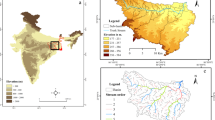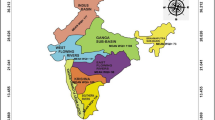Abstract
Entropy weight model (EWM) is widely used in water quality evaluation. In the conventional EWM, the weight is a monotone increasing function of the dispersion degree. However, this weighting principle often neglects the heavily polluted indicators. To solve this problem, an improved EWM is designed, in which the weight of the indicator is a compound function of its dispersion degree and pollution degree. In the clean domain, the weight increases with the dispersion degree, while in the polluted domain, the weight decreases with the dispersion degree. And for the same dispersion degree, the larger the pollution degree is, the higher the weight is, and vice versa. Subsequently, the improved EWM is applied to the water quality evaluation of Wucheng Wetland in Poyang Lake, China. Results are as follows: (i) For TP, CODMn, and NH3-N, their dispersion degrees are 0.001, 0.158, and 0.084; and their pollution degrees are 0.971, 0.277, and 0.281, respectively. (ii) According to the improved EWM, the weights of TP, CODMn, and NH3-N are 0.613, 0.197, and 0.190, respectively. (iii) The comprehensive water quality indices of estuary region, wetland region, and the central lake area are 32.5, 30.9, and 35.6, respectively, all of which belong to a “bad” grade. The water environment of Wucheng Wetland suffered serious damage of phosphorus, and the ecosystem faced a high threat. (iv) Compared with the conventional EWM, the improved EWM highlights the importance of polluted indicators, which makes the comprehensive evaluation results more rigorous and reasonable.


Similar content being viewed by others
Data availability
All the data are included in Table 2.
References
Avvannavar, S. M., & Shrihari, S. (2007). Determination of water quality deterioration at pilgrimage centre along river Netravathi, Mangalore using WQI approach. Environmental Engineering and Management Journal, 6(2), 123–131.
Agency, C. E. P. (2002). National surface water environmental quality standards of China (GB-3838-2002). China Standards Press.
Dai, X. Z., & Hu, Z. P. (2019). Study on resources and environment of Poyang Lake. Science Press.
Finney, W., & Giordano,. (2004). Thomas’ calculus. Higher Education Press.
Fang, N., You, Q. H., Liu, L. L., Li, J. Y., Lu, C. F., Zhang, L., Yang, T., Yu, Z. P., Lǖ, Z. L., & Yang, W. J. (2019). Evaluation of eutrophication in Poyang Lake wetland during autumn based on cloud model. Acta Ecologica Sinica, 39(17), 6314–6321.
Hu, Z. P. (2020). Hydrological and ecological characteristics and evolution of Poyang Lake. Science Press.
Huang, X., Guan, Z. Y., Wang, Q., & Qiu, L. (2012). Application of refined set pair analysis to comprehensive evaluation of lake water quality. Water Resource and Hydropower Engineering, 43(1), 35–37.
Kannel, P. R., Lee, S., Lee, Y. S., Kanel, S. R., & Khan, S. P. (2007). Application of water quality indices and dissolved oxygen as indicators for river water classification and urban impact assessment. Environmental Monitoring and Assessment, 132(1–3), 93–110.
Liu, L., Zhou, J. Z., An, X. L., Zhang, Y. C., & Yang, L. (2010). Using fuzzy theory and information entropy for water quality assessment in Three Gorges region. China. Expert Systems with Applications, 37(3), 2517–2521.
Liu, T. K., Yu, J. L., Chen, C. L., & Wei, P. S. (2012). Information theoretic perspective on coastal water-quality monitoring and management near an offshore industrial park. Environmental Monitoring and Assessment, 184(8), 4725–4735.
Li, R. F., & Zhang, Y. (2011). Analysis of spatial and temporal variation of water quality and its influencing factors in Poyang Lake. Water Resources Protection, 27(6), 9–13.
Mogheir, Y., & Singh, V. P. (2002). Application of information theory to groundwater quality monitoring networks. Water Resources Management, 16(1), 37–49.
Qian, B., Zhu, Y. X., Wang, Y. X., & Yan, F. (2020). Can entropy weight method correctly reflect the distinction of water quality indices? Water Resources Management, 34(11), 3667–3674.
Sahoo, M. M., Patra, K. C., Swain, J. B., & Khatua, K. K. (2016). Evaluation of water quality with application of Bayes’s rule and entropy weight method. European Journal of Environmental and Civil Engineering, 21(6), 1–23.
Singh, K. R., Dutta, R., Kalamdhad, A. S., & Kumar, B. (2019). Information entropy as a tool in surface water quality assessment. Environmental Earth Sciences, 78(1), 1–12.
Shannon, C. E. (1948). A mathematical theory of communication. Bell Systems Technical Journal, 27(4), 623–656.
Taheriyoun, M., Karamouz, M., & Baghvand, A. (2010). Development of an entropy- based fuzzy eutrophication index for reservoir water quality evaluation. Iranian Journal of Environmental Health Science and Engineering, 7(1), 1–14.
Vraneevi, M., Beli, S., Kolakovi, S., Kadovic, R., & Bezdan, A. (2017). Estimating suitability of localities for biotechnical measures on drainage system application in Vojvodina. Irrigation and Drainage, 66(1), 129–140.
Wang, S., Huang, J., Feng, S. L., Wan, Z. H., & Wang, Q. (2019). Application of CCME WQI in water quality assessment of Seagoing rivers (the Aojiang River) in China. Environmental Monitoring in China, 35(4), 93–99.
Wang, Y. K., Sheng, D., Wang, D., Ma, H. Q., Wu, J. C., & Xu, F. (2014). Variable fuzzy set theory to assess water quality of the Meiliang Bay in Taihu Lake Basin. Water Resources Management, 28(3), 867–880.
Wang, Y. M., Wu, Y. F., & Jiang, L. (2020). Application of interval information comprehensive ranking model based on entropy weight in river water quality evaluation. Journal of Coastal Research, 105, 137–140.
Wang, Z., Xing, X. G., Yan, F. (2021). An abnormal phenomenon in entropy weight method in the dynamic evaluation of water quality index. Ecol Indicators, 131.
Yang, G. H., & Cui, B. (2011). The application of entropy weight method to evaluation of the sustainable utilization of water resources. Mathematics in Practice and Theory, 41(19), 8–12.
Yang, J. Y., & Zhang, L. L. (2012). Fuzzy comprehensive evaluation method on water environmental quality based on entropy weight with consideration of toxicology of evaluation factors. Advanced Materials Research, 356–360(1–5), 2383–2388.
Yi, F. H., Chen, Li., & Yan, F. (2019). The health risk weightin g model in groundwater quality evaluation. Human and Ecological Risk Assessment, 25(8), 2089–2097.
Yan, F., Liu, L., Li, Y. F., Zhang, Y., Chen, M. S., & Xing, X. G. (2015). A dynamic water quality index model based on functional data analysis. Ecological Indicators, 57, 249–258.
Zhang, X. Q., Feng, W. H., & Li, N. N. (2010). Attribute recognition model based on entropy weight and its application to evaluation of groundwater quality. Applied Mechanics and Materials, 29–32, 2698–2702.
Zhang, X. Q., Liang, C., & Liu, H. Q. (2007). Application of improved TOPSIS method based on coefficient of entropy to comprehensive evaluating water quality. Journal of Harbin Institute of Technology, 39(10), 1670–1672.
Zhu L. Z., Xing, X. G., Yan, F., Lopes A. M. (2021).The abnormal phenomena of entropy weighting method in the dynamic evaluation of agricultural water conservation. Mathematical Problems in Engineering.
Zhu, Y. X., Tian, D. Z., Yan, F., (2020). Effectiveness of entropy weight method in decision making. Mathematical Problems in Engineering, 1–5.
Zou, Z. H., Sun, J. N., & Ren, G. P. (2005). Study and application on the entropy method for determination of weight of evaluating indicators in fuzzy synthetic evaluation for water quality assessment. Acta Scientiae Circumstantiae, 25(4), 552–556.
Funding
This research was funded by the National Natural Science Foundation of China (52069012), and the 2021 Annual Scientific Research Program of Wanjiazhai Water Holding Group Co., Ltd. (Grant No. 2021−30).
Author information
Authors and Affiliations
Contributions
Luo Xi wrote the paper. Zeng Qin collected the data. Yan Feng did the modelling and statistical analysis.
Corresponding author
Ethics declarations
Competing interests
The authors declare no competing interests.
Ethics approval
Not applicable.
Consent to participate
Not applicable.
Consent for publication
All authors have duly consented to publish this manuscript.
Additional information
Publisher's Note
Springer Nature remains neutral with regard to jurisdictional claims in published maps and institutional affiliations.
Rights and permissions
Springer Nature or its licensor holds exclusive rights to this article under a publishing agreement with the author(s) or other rightsholder(s); author self-archiving of the accepted manuscript version of this article is solely governed by the terms of such publishing agreement and applicable law.
About this article
Cite this article
Xi, L., Qin, Z. & Feng, Y. The improved entropy weighting model in water quality evaluation based on the compound function. Environ Monit Assess 194, 662 (2022). https://doi.org/10.1007/s10661-022-10304-4
Received:
Accepted:
Published:
DOI: https://doi.org/10.1007/s10661-022-10304-4




